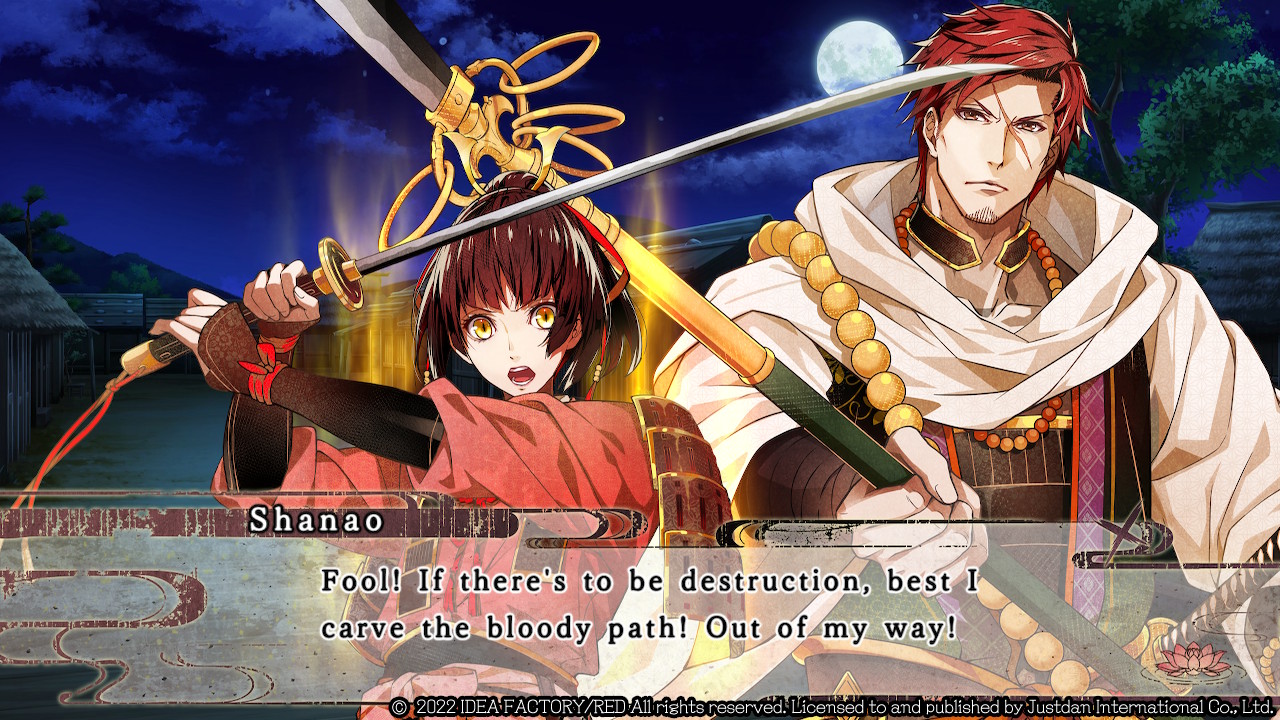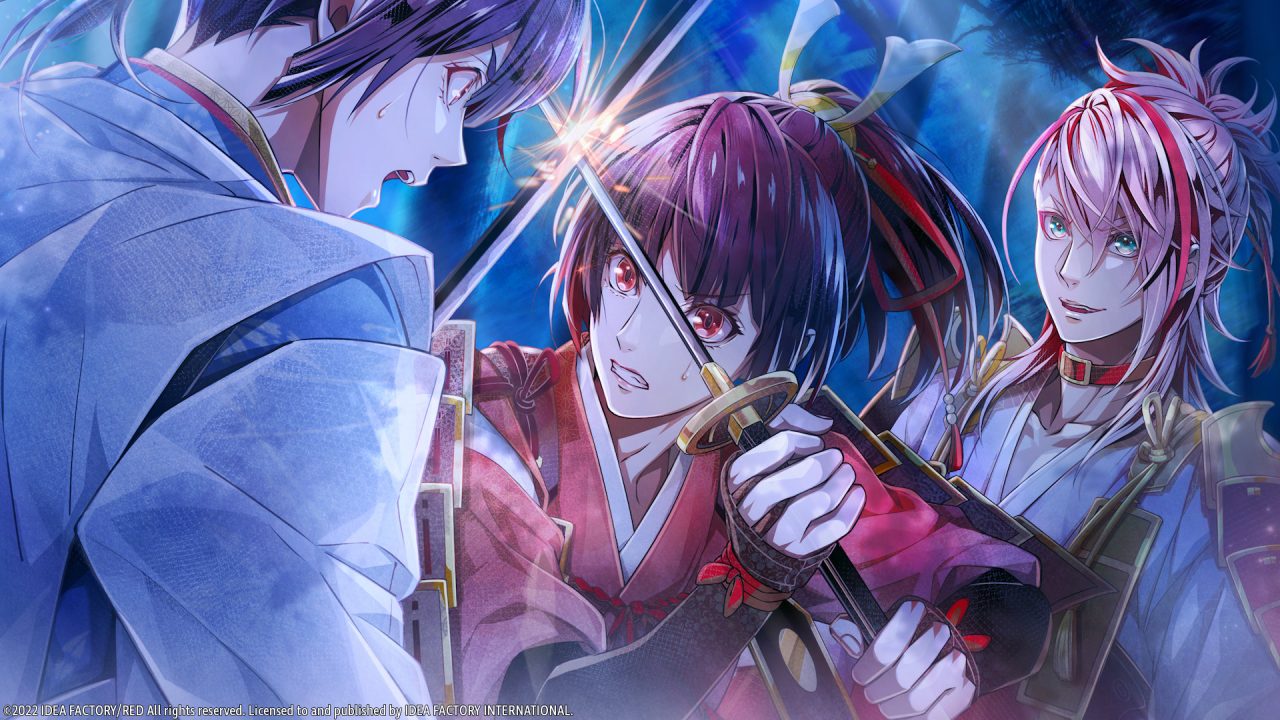Birushana: Rising Flower of Genpei is a historical fantasy otome that adds magical elements to the Genpei War, not unlike the fantastical liberties taken in the otome all-star Hakuoki. Far from being “the next Hakuoki”—although that itself is great praise—Birushana carves out a distinct identity by taking some liberties with certain routine otome features. Some of these changes are admittedly minute and therefore don’t make a consequential impact on the game. But the majority of changes allow Birushana to blossom into a narrative experience that shouldn’t be passed up.
The first and most upfront of Birushana’s unique attributes is its protagonist, Shanao. Although active protagonists with their own character arcs continue to take center stage in more and more recent otome titles, Shanao kicks things up a notch with her physical strength and leadership. Raised in secrecy as the male heir of the Genji, Shanao stands toe to toe with her male love interests as a highly-skilled warrior and eventually makes her way up the ranks as a lord with vassals. Even clearly defined otome protagonists may still sometimes fill a more passive role and leave the bulk of the activity to the love interests, but Shanao instead takes up her sword and leads the story forward as an equal to her male peers.
Birushana’s story, with its epic battles and compelling lore, also shakes up the usual visual novel presentation by implementing far more “animation.” Static character portraits may be par for the course in the genre, but Birushana makes use of a respectable number of portraits for each major character with swords drawn in various poses, including some that even face backward. These sprites are used to great effect, shown moving across the screen and clashing with each other—complete with visual and sound effects—to convey what would otherwise be relegated only to narration and perhaps a CG of a few sword slashes. Although these animations are simple, they breathe a lot of life into the fight scenes that comprise much of the story. This also helps take some of the pressure off the writing, too: instead of relying on text to describe each and every sword swing, this visual shorthand represents the movement. The narration is left to explain the most essential actions instead, alleviating any potential fatigue reading through fight scene after fight scene.

Because the story of Birushana revolves around the Genpei War, each route features the same significant battles. Still, they play out very differently each time due to the altered circumstances Shanao finds herself in. Variations such as who comes up with what strategies, who crosses swords with whom, and who makes what decisions based on the information they do or don’t have create satisfying—and major—changes between routes. The guarantee that each battle will play out with drastic variations and lead to different scenes also ensures that readers aren’t bored experiencing the same skirmishes five times throughout the game.
Some scenes surrounding these fights don’t have that same luxury, however. It’s not unusual for visual novels to have the same events to play out across various routes with just a handful or even a single line altered. But in such a case, players can skip what’s already been read with the few new lines highlighted. While Birushana’s “shared route” chapter sections are skippable after the first read, various other scenes—when you first meet Takatsuna, when the messenger directs your forces to the Fuji River, and even when you first arrive at the Fuji River camp and meet Kagetoki—can’t be skipped even though the dialogue doesn’t change. This may have something to do with how the scenes are “categorized;” these scenes aren’t listed under “shared route” chapters despite being nearly identical across routes, and they actually happen in different chapters, too: what may happen in Chapter 6 in Shungen’s route could occur in Chapter 7 in other characters’ routes, and even in Chapter 8 in someone else’s.
The different pacing for each character proves how the routes properly change each time, even with the repeated battles. Still, it should be possible to skip previously-read text regardless of its chapter placement and appearance order. It’s all too easy to lose yourself in button-mashing mode when you see the relentless stream of previously-read conversations, but then you may skip the unread tweaks between routes. I approached Tomomori’s route last, and I tried to rush through the repeated lines of the first strategy meeting scene because I had read them multiple times before. As a result, I almost missed out on the subtle differences present in his route’s version of that meeting as I mashed through the text. The ability to skip what’s already been read and stopping it at new lines draws attention to those new lines, emphasizing the crucial differences between routes, rather than risking them getting lost in the torrent of repetition.
Getting through each route is also slightly different compared to the usual otome game. Birushana changes up the typical method of progression by adding three stats in addition to the love interests’ affection: strength, knowledge, and kindness. Additional stats aren’t unheard of for the genre, but it’s also sometimes tricky to implement well. In Birushana, these stats don’t feel very necessary and instead come across as either missed potential for a more in-depth progression system or something that could have been done away with altogether. The ability to jump to particular chapters generally alleviates any troubles caused by such systems, but even with Birushana’s in-depth flowchart, which allows players to start at almost any point in the story and choose what stats are “high” (maxed out) or “low” (completely empty), it’s still a little awkward.
For instance, when I put in all high stats to start Tomomori’s route, I got a bad ending right away… in which Shanao laments that she “wasn’t strong enough” to get away from him. High stats but low affection didn’t move us forward, either. Putting in all low stats, however, gets you past this bad ending—and all the way to Tomomori’s “happy ending.” Even if it vaguely makes sense by the end of the route why your stats need to be low to get his best ending, you have to fight generals, armies, and even stronger, supernatural forces to get to that point. Shanao is simply not a character I would ever consider to have “low strength, knowledge, or kindness” under any circumstances, in spite of what the stats suggest or sometimes even require.

Affection, on the other hand, is handled in a manner no different from the usual otome title, but this is to Birushana’s benefit. Choices that affect affection are far, far more common than choices that affect stats. In the aforementioned Tomomori route, five of the six choices given are for affection, and there’s a clear indicator to display how much affection was influenced: no graphic for no change, a slightly blooming flower for an okay answer, and a fully blooming flower for the best answer. This makes it easy for players to quick save at a decision and go with the choice that gives them their desired result. But it’s impossible to know whether the non-affection stats you’re raising will lead you to a good ending or not, and there usually aren’t enough stat choices to make a difference, anyway. A system using only affection would give the player more control over the endings they get since they can clearly see how the choices affect the stat—and is quite appropriate for a game in which the protagonist is very in control of paving the way towards her own future. It would also help alleviate the slight disconnect between Shanao’s character and her stat’s attributes, as well as simplify a system that doesn’t need to be complex.
An element that Birushana does simplify effectively is its approach to pseudo-love interest secondary characters. Some especially standout members of the game’s extensive secondary cast get “endings” of their own that will unlock as you complete the main routes. By relegating these cute, romantic “endings” to singular chapters, Birushana‘s already massive story remains manageable by keeping the total number of full routes down while still offering cute, romantic chapters to give more depth to Tsugunobu, Tadanobu, Takatsuna, and Shigehira. The only nitpick I have about this system is that as I unlocked these endings, I was expecting one character in particular, Yasuhira, to receive one as well. He was one of the very few characters who felt a little underdeveloped, and such a chapter could have potentially expanded his character, in addition to giving each of the five main routes a bonus chapter rather than leaving one with none.
Still, it’s a testament to Birushana’s quality that one of the few gripes I have is that I want more of it. Although the game has a few hiccups, they’re safely surface-level, and don’t remarkably hinder the story or its compelling cast of characters. Although it’s appreciated when an otome title tries to add complexity to the progression through the use of stats or other features, the main reason why one plays otome games isn’t for their mechanics but for their love interests and the world they inhabit—and Birushana delivers both with flying colors. While it’s already a must-play for fans of historical fantasy and samurai warfare, Birushana will no doubt appeal to anyone interested in exciting battles, intriguing mysteries, memorable characters, and a few unique twists on the usual otome tropes.


